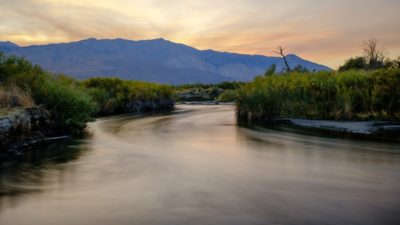1. DEATH VALLEY FURNACE CREEK VISITOR CENTER
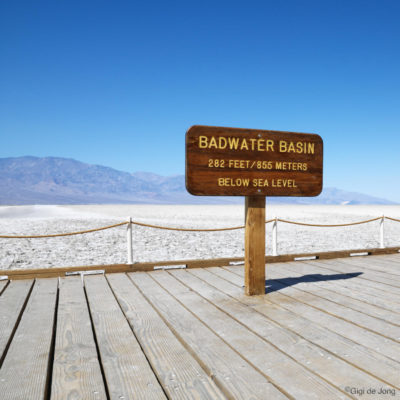
Badwater Basin, lowest point in North America.
Furnace Creek was originally a mining settlement known as Greenland Ranch. Today it is the tourism hub of the magnificent Death Valley National Park. The National Park Service and concessionaires maintain a beautiful and sprawling complex here of hotels, golf course, campgrounds, visitor center, shops, swimming pool, playgrounds, and a single-runway, civil aviation airport.
The Park covers 3,000 square miles of southeastern Inyo County and the lowest point on the North American continent is just 15-miles south of Furnace Creek. It is known as Badwater Basin and sits at 282 feet below sea level. The summer heat is intense and the salty water is undrinkable, and yet it is home to an amazing number of tiny plants, animals, and aquatic insects.
Furnace Creek, which is 190 feet below sea level, holds the distinction of having the highest ever recorded temperature on earth. On the afternoon of July 10, 1913, the ambient air temperature was recorded at a blistering 134.1 degrees Fahrenheit. Despite the park’s macabre name, this monumental landscape is strikingly beautiful and does, in fact, sustain a large variety of life.
2. ALABAMA HILLS NATIONAL SCENIC AREA
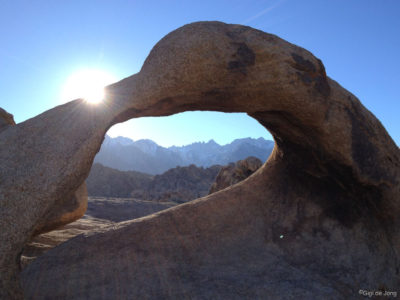
Mobius Arch frames Mt. Whitney and the Sierra Nevada skyline
Nestled in the foothills of the Sierra Nevada, below Mt. Whitney and just west of Lone Pine, the Alabama Hills National Scenic Area has been one of Hollywood’s favorite filming locations since the early 1900s. The beautiful, rounded rock formations of the hills bordered by a vast open plain that rises dramatically and near‑vertically for almost 10,000 feet to the rugged, snow-capped mountains beyond has created a monumental landscape evocative of the old west.
One of the most striking formations is a natural arch, the Mobius Arch. It is perfectly situated and large enough to create a picturesque window through which to view Mt. Whitney (the tallest peak in the contiguous USA) in the distant skyline of the Sierra Nevada. Sunsets are often astoundingly beautiful here.
Although only a few miles from town this 30,000-acre protected area can give one the feeling of being ‘way out there.’ It is a wonderful, family-friendly place for auto touring, cycling, hiking, rock climbing, trail running, horseback riding, fishing, and camping. Pick up a map of the famed movie-set locations from the nearby Museum of Western Film History.
3. MT. WHITNEY
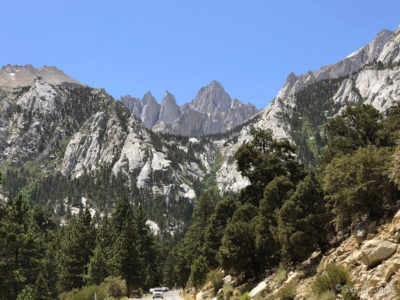
Mt. Whitney from just below the portal
Mt. Whitney is the highest point in the contiguous USA at 14,505 feet above sea level. It is a mecca for adventurers from around the world. Ascending the trail to the top of this mountain is for experienced hikers and requires planning and training. If that’s you, find out more about securing day use or overnight permits here.
An excellent family-fun excursion to Whitney Portal is great way to get up close and personal with this mountain. A paved, winding mountain road provides breathtaking views along the way of the vast landscape below and the towering peaks above. A 12-mile drive from Lone Pine delivers you to the portal where the trailhead to the mountaintop is located. There’s plenty of parking, campgrounds, vault toilets, a café for the hungry, and a magnificent waterfall. This is definitely a ‘bucket list’ kind of place and even if you don’t climb to the highest point on the continental US, you can say, “I have ascended to the portal!”
4. MUSEUM OF WESTERN FILM HISTORY IN LONE PINE

Museum of Western Film History in Lone Pine
In lovely Lone Pine, gateway to Death Valley and Mt. Whitney—the lowest and highest points in the continental USA respectively, is an unpretentious stucco building that houses one of the finest collections of movie memorabilia. It is the Museum of Western Film History and it showcases the pride of Hollywood’s western filmmaking. Fondly called Hollywood’s largest back lot, the Alabama Hills have provided some of the greatest scenic settings in film and television for over 100 years.
Explore the museum’s extensive collection of real movie costumes, movie cars, carriages, original cameras, props, posters, and loads of other fascinating movie memorabilia. Grab a brochure of the back lot and take a self-guided tour along Movie Road and around the Alabama Hills.
5. ANCIENT BRISTLECONE PINE FOREST / SCHULMAN GROVE
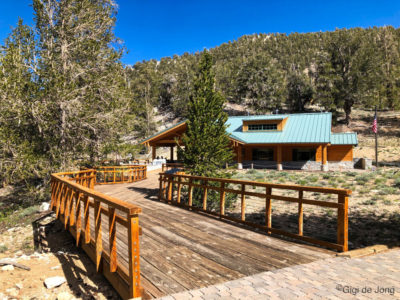
Schulman Grove Visitor Center located above Bishop at 10,000′ ASL
The oldest living things on our planet live in the White Mountains above Bishop. They are trees! Many of the individuals in the Ancient Bristlecone Pine Forest are well over 4,000 years old and still living. The oldest living tree, named Methuselah, is almost 5,000 years old. These Great Basin bristlecone pines (Pinus longaeva) are weather-beaten, gnarled, and resilient. They grow between 9,000 and 11,000 feet above sea level in a habitat that is essentially inhospitable to most other life.
A visit to this awe-inspiring forest is a wonderful experience for the whole family. The Schulman Grove Visitor Center is wheelchair accessible and many old trees can be seen from the deck and boardwalks. Visitors say they feel a sense of awe and peace when they walk the trails that weave through the groves of old and young bristlecones. These trees have become known as “the trees that rewrote history.” Come and see why.
6. MANZANAR NATIONAL HISTORIC SITE

Manzanar National Historic Site memorial
Over 10,000 Japanese American citizens and resident Japanese aliens (men, women and children) spent all or part of World War II detained in this facility. It was called the Manzanar War Relocation Center and was one of ten such camps in the US that, in total, interned almost 120,000 people during WWII. The Manzanar National Historic Site and memorial is a stirring reminder of a period in our history that should not be forgotten.
The Manzanar Visitor Center and a few remaining original structures are in a large tract of land (814 acres of an original 6,200 acres) just 10 miles north of Lone Pine. The center has 8,000 square feet of exhibits, a bookstore, and a theater that shows the award winning 22-minute documentary, Remembering Manzanar. A centerpiece of the exhibit is a large graphic with the names of over 10,000 Japanese Americans who spent many years in this detention facility. Among its other exhibits is a large-scale model of the Manzanar War Relocation Center crafted by former internees. The facility was designated as a National Historic Site in 1992 and is managed by the National Park Service.
7. BISHOP CREEK CANYON

Fall colors along South Rd. in Bishop Creek Canyon
Bishop Creek Canyon is a large area of about 30 square miles where the North, Middle, and South Forks of Bishop Creek drain down toward the Owens Valley. Along each fork high in the mountains are large lakes, North Lake, Lake Sabrina at middle fork, and South Lake. Numerous other smaller lakes lie along these creeks. It is the preeminent camping destination in the Eastern Sierra with a dozen campgrounds offering a total of over 250 campsites—all in idyllic settings with plenty of space and easy access.
Less than 20-miles west of Bishop, this long, deep canyon with its the towering mountains, alpine forests, large lakes, and rushing streams will give you the feeling of being worlds away. Easy access to stream and lake fishing is a big draw for visitors and locals alike and yet solitude is also easy to find. Numerous trailheads begin in this canyon where you can truly get away from the pressures of daily life and into the adjacent wilderness.
8. BUTTERMILK RECREATION AREA

Bouldering in Buttermilk Country © Jeff Deikis
The Buttermilk Recreation Area, just 13-miles west of Bishop along CA-168 W (W. Line St.) is best known as a world-class bouldering destination and yet it is so much more. It is a wonderful area for hiking, trail running, mountain biking, rock hounding, stargazing, and OHV exploring. The designated recreation area covers 325 acres of high desert meadow interspersed with rocky hills and burbling creeks and a network of undulating trails and tracks. It is a year-round destination and there is something here for everyone.
Buttermilk Country and its neighbor the Tungsten Hills appear to be foothills of the Sierra Nevada, but these hills are the result of a combination of alluvial fill and deposits by glacial action from the last ice age. The massive boulders that are strewn on these hillsides were pushed by advancing glaciers and then ‘left there’ once the glaciers retreated. They provide some of the most accessible and diverse bouldering in the country with routes that offer everything from fun scrambling to highly technical ‘problems’ that challenge even the world’s best climbers.
9. OWENS RIVER
The perennial Owens River flows down from the escarpment above Bishop, through a deep gorge it has cut during the last 750,000 years. It weaves sinuously around the town and south to the Owens Lake and, as it goes, it creates a verdant, riparian area along its banks. Tributaries that stream down from the massive Sierra Nevada to the west flow into the Owens River at points along its journey south. These creeks and canals broaden into pools and ponds—and life flourishes.
In summertime, ‘floating the river’ is a favorite activity. Even though daytime temperatures can soar over the 100 deg mark, a float tube ride on the slow, smooth water of the river is cooling and relaxing. A late afternoon swim in one of the artesian wells or spring-fed ponds is sublime on a hot summer day. Fly fishing anywhere along the river is fantastic, and legal—every day of the year! Fishing in the Buckley Ponds just east of Bishop can yield bass, bluegill, carp and even catfish and is a wonderful wintertime fishing experience. This river sustains us and gives us pleasure.
10. DOWNTOWN BISHOP MURALS
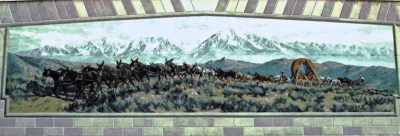
Twenty-two Mule Team mural on Union Bank north wall
On buildings throughout Bishop the history of the Owens Valley is depicted on the exterior walls in the form of historically accurate and visually beautiful murals. The Bishop Mural Society was established in 1997 “to display our heritage in a spectacular outdoor art gallery surrounded by natural beauty.” Today there are fifteen murals, the most recent of which is made up of 421 sculpted ceramic tiles and mosaic, created by 216 community members.
The society is a founding member of the California Public Art and Mural Society and mural projects are ongoing through the generous support of the community. Pick up a map at the Bishop Visitor Center, or download it here, and read the story about each mural online on the society’s webpage. Take a walk around Bishop and see the history of this region artfully rendered in full color and larger-than-life.
11. LAWS RAILROAD MUSEUM AND HISTORICAL SITE

The Depot at Laws Railroad Museum and Historic Site
Laws Railroad Museum and Historical Site is a look back in time to when a railroad station was the heart of a bustling western town. The site houses many original buildings, train engines and cars, salvaged and restored structures, and thousands of artifacts that celebrate the rich history of this railroad and life as it was almost 150 years ago. It safeguards the memories and experiences of a not-so-long-ago era of railway magnates, miners, farmers, fortune seekers, high Sierra adventurers, and travelers who rode the Slim Princess.
In addition to the extensive museum exhibits, the site offers train rides on the authentic, restored railroad cars and hosts many family-fun events including, the Laws Good Old Days, the Laws Museum Picnic Concert, and the annual holiday Railroad Express.
12. OWENS VALLEY PAIUTE SHOSHONE CULTURAL CENTER

Paiute Shoshone Cultural Center
Well before explorers and settlers ventured into Payahuunadü – Land of the Flowing Water, the Nüümü – the People (Owens Valley Paiute) were living, thriving, and producing works of art according to age-old cultural traditions. The history of the first people of this land can be seen in the wonderful displays of art and craft at the Paiute Shoshone Cultural Center on West Line Street in Bishop. The center is a ‘living center’ that serves as a showcase for historical archives, artifacts, and media as well as a place to gather, teach, and continue the traditional ways. The museum gift shop offers locally made arts and crafts for purchase.
Stop in and say, “Manahuu” (Hello).
13. LAKE SABRINA (ELEVATION 9,128’)

View of Sabrina Lake basin from the cafe patio
West of Bishop, at end of California Highway 168 West (W. Line St.) sits the beautiful Lake Sabrina. Locals pronounce it “Suh-BRY-nuh” and no-one really knows why—we just do. This beautiful blue lake sits at a little over 9,000 feet above sea level surrounded by alpine forest and the tall craggy peaks of the Sierra Nevada. The lake level fluctuates seasonally and annually, but the beauty of the area never diminishes.
A quaint café and boat landing, Lake Sabrina Boat Landing and Café, alongside the dam are open and accessible by road from spring to fall each year. Early autumn here produces one of the most spectacular fall color displays in all of California. This lake is perfect for a family adventure. There’s hiking, swimming, kayaking, fishing, leaf peeping, camping, eating, photographing and so much more.
14. SOUTH LAKE (ELEVATION 9,750’)
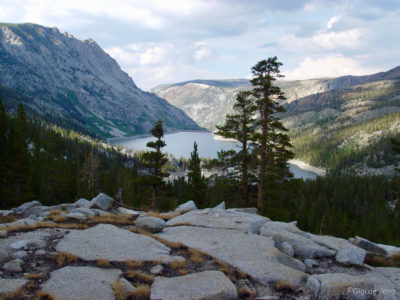
View of South Lake from Treasure Lakes trail
South Lake is one of three large lakes in Bishop Creek Canyon – the jewel in the crown of Bishop’s outdoor activities. It sits along the South Fork of Bishop Creek and is a popular destination for locals and visitors. A beautiful drive of about 30 minutes and 22 miles along CA-168 W. (W. Line St.) from the center of Bishop terminates above the shore of the lake.
Go for an easy outing of fishing, boating, swimming and splashing. Bring your own watercraft or rent one at the South Lake Boat Landing. Take a short hike, birdwatch, and come for the fall colors. This a premier destination for fall color spotting. Big mountain adventures begin here at the Bishop Pass Trailhead. Go trail-running, trekking, camping, mountaineering, and head out into the wilderness.
Vehicle access to the lake and trailhead is seasonal from spring to fall each year. In winter when the snowpack is right, the road becomes a cross-country ski and snowshoe trail for the more experienced winter adventurers.
15. NORTH LAKE (9,350’)

North Lake in fall colors
This gorgeous emerald lake is the smallest of the three high-altitude lakes accessible by road in Bishop Creek Canyon. It lies along the North Fork of Bishop Creek and, when dressed in its fall colors, it is the iconic High Sierra image. It is accessible by road, from spring to fall, and all but one half-mile is easy driving with stunning scenery. That ½-mile is even more spectacular, but not for the faint of heart. This lake is a prime destination for fall color photography.
Drive 18-miles from the center of Bishop along CA-168 W (W. Line St.) and turn right onto North Lake Road. The road is paved on the steep sections and graded gravel along the mountainside traverse (that’s the scary bit) and around the lake. A coral and stables are the summer home to Bishop Pack Outfitters where adventure has legs. Take a mule pack trip into the backcountry, or fish, hike, camp, run, birdwatch, and take plenty of photographs.
16. KEOUGH’S HOT SPRINGS

Historic Keough’s Hot Spring resort
The historic Keough’s Hot Springs resort, located 8.4 miles south of Bishop (just a 10-minute drive) on US-395, was a favorite luxury getaway for the early Hollywood stars in the 1920s & 30s. Today it’s still a favorite among locals and visitors for a delightful family fun outing.
The tradition of healing through natural mineral, geothermal spring water is hundreds of years old, and this place continues the tradition with rustic, old-world charm. Much of the original wooden structure is still intact and the two pools, a large warm swimming-pool and a smaller hot soaking-pool, are the original ones built in 1919. A constant flow of hot, fresh mineral water fills the pools, making this a wonderful place to languish in these restorative waters. Enclosed on all four sides the pools are protected from the desert wind, but open to the sky above. Keough’s was conceived as a place to get away and get close to nature. Almost 100 years later it still delivers on that promise.
17. VOLCANIC TABLELANDS/CHALK BLUFF – HAPPY AND SAD BOULDERS

View from the top of Chalk Bluff. @davidvonnegutchambers
Just north of Bishop a 300-foot-high bluff stretches for 5-miles across the northern Owens Valley. Known as Chalk Bluff, this impressive escarpment marks the southern end of the Volcanic Tablelands that were formed by a massive volcanic explosion about 760,000 years ago. The eruption produced a pyroclastic flow that deposited an extensive layer of volcanic material between the White Mountains to the east and Sierra Nevada to the west. Eons of wind and water have sculpted the rock we now call Bishop Tuff into a playground for bouldering, trail-running, hiking, bike riding, and OHV driving.
Of the many small canyons that were etched into the bluff, two are well known for fun and challenging bouldering – they are the Happy and the Sad Boulders. The Happys offer warmth and shelter from the wind on blustery winter days and the Sads can be perfect on hot days due the narrow, catacomb-like channel. A short, but steep trail leads into each canyon and the views out across the valley toward the towering Sierra Nevada are awe-inspiring. The plateau above the bluff is vast with an extensive network of trails, tracks, and dirt roads that are great for trail-runs, gravel-grinder bike rides, and dirt-biking.
18. WANAAHA CASINO

Wanaaha Casino in Bishop
The Wanaaha Casino in Bishop (pronounced WA-NA-HA) is the Eastern Sierra’s newest and best Vegas-style gaming casino. Owned by the Bishop Paiute Tribe, the fifth largest tribe in California, the casino offers slots, table games, video keno & poker, and live & tournament poker. Three dining options cater to a variety of tastes and styles. The Paiute Deli serves up fresh pizza, whole or by the slice, sandwiches, subs, hot dogs, nachos and more. The Lounge is the ultimate sports bar experience, and the TuKaNovie (meaning ‘eating house’ in the native language) is a full service restaurant where you can sit, relax, and eat a leisurely meal paired with a good wine. It’s a great place for a good time.
19. BISHOP CITY PARK
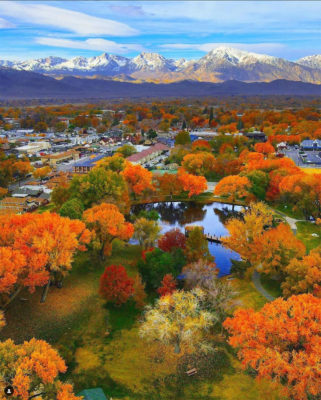
Bishop City Park aerial view in fall. @mike_h_tran
Bishop City Park comprises 44 acres of parkland where the city maintains a swimming pool (open from Memorial Day to Labor Day), baseball fields, tennis courts, a skate park and bike park, an off-leash dog park, picnic tables and picnic pavilion, a beautiful pond and over-water gazebo, children’s play structures, outdoor fitness center and bocce court. A paved path meanders under shade trees, alongside a burbling stream, around the pond and out onto the gazebo on the pond. See the fish swimming in the clear waters below and watch the ducks and colorful birds on and around the pond. The city park is the heart of Bishop with easy access on safe sidewalks to shops, restaurants and entertainment facilities – many of which have access for the handicapped.
Pop over the Bishop Visitor Center to buy a small bag of approved seed to feed the ducks. We prefer that you DO NOT feed our ducks and fish bread, which is less nutritious than quality seed. Approved seed keeps our ducks healthy and the water cleaner and safer for all our wild friends.
20. BISHOP VISITOR CENTER
Bishop is the heart of the Eastern Sierra – “The small town with a big backyard.” Within little more than a one-hour drive either north or south on US Highway 395, or up into the White Mountains to the east, or west up to lakes and trailheads of the Sierra Nevada there’s a lifetime of exploration and grand experiences to be had here.
Pick your path by popping into the Bishop Visitor Center at 690 N. Main St. in Bishop. The knowledgeable, friendly staff can provide information, maps, and brochures. They can make suggestions about local events and what activities are best at which locations, depending on the season and the weather conditions. They can make recommendations on lodging, dining, and shopping.
These are some of the many activities that can be done in our big backyard: fishing, rock climbing, road biking, mountain biking, trail running, photography, fall color spotting, birding, swimming, kayaking, snow sports, flying, OHV driving, hiking, camping, rock hounding, hot tubbing, and even more. Our small town has all the amenities for fun vacations with great lodging, excellent restaurants, bars, breweries, distillery, bakeries, specialty shops, galleries, and museums. Most are independently owned and operated and you’ll get a unique experience with local flavor.
